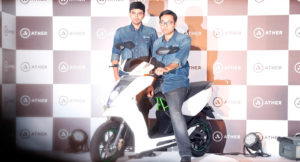Airveda’s air quality monitor helps assess the pollution levels and enables individuals to take life-impacting decisions for better quality of life.
Namita Gupta, an IIT-Delhi graduate who was formerly in the U.S. for 13 years and had worked in Microsoft and Facebook (seven and six years, respectively), was back in New Delhi in 2013. She was asthmatic as was her young daughter. “My condition aggravated and I was concerned about my children. The older one was already asthmatic,” she recollects. Though she was glad to be back, health concerns made her wonder if the family should go back to the U.S. This doesn’t come as a surprise as New Delhi has been declared the most polluted city in the world by the WHO. The government has tried to initiate measures such as the much debated odd-even number plates on alternate days to reduce the number of cars on the road, bringing down not only traffic, but air congestion as well. However, there is no way to measure its effectiveness on traffic or the atmosphere.
Gupta wanted to take matters into her own hands and bought an air quality meter. This helped as it gave her an indication of the quality of the air and whether the air purifier she was using was effective or due for maintenance. This significantly helped her health and gave her a sense of control. “This process led to my first a-ha moment,” she says.
She also thought of where her family spent most of their time – the school, neighbourhood, restaurants and other such places. She came to the conclusion that once people care for the quality of the air and demand better air, businesses would be compelled to ensure they do something about it.
The next step was to make people aware of how measuring and taking action was helping her. She posted in her apartment group about the quality of air in the complex which was 300 times more polluted than permissible levels. That year the residents avoided burning crackers for Diwali. She was overwhelmed by the response and realised that, there was concern, but no direction as to how to go about getting one’s right to breathe pure air. When aware, people were willing to change their behavior and contribute to the cause.
Navigating the research
The New Delhi government has installed monitors in a few places, but pollution levels vary in different neighbourhoods and need to be treated accordingly. Identifying the cause to implement an ideal solution is important as is real time assessment. In Singapore, for instance, schools close if on a day the pollution level rises. Beijing had the odd-even rule only when air pollution was high. So, central to any effort in controlling air pollution is data, and a system to aggregate and communicate this data is missing in India.
Whenever i walk into a school with a model for demo they ask me to leave it behind and raise an invoice. Parents are asking about the air quality in schools and this is a good way for the management to reassure them.
Gupta decided that there was a definite need for portable, accurate monitor. Her father ran a manufacturing unit in Delhi, and her brother, Prashant Gupta, a hardware engineer, was working in the family business. The siblings partnered to study existing air monitoring systems many of which require huge investments. The first logical step was to know what to measure since there are many pollutants. “We decided to focus on particulate matter since there is more research and regulation associated with it,” Gupta explains while adding that the team also understood how to measure the matter. Currently, there are six air monitors installed in New Delhi, each of which cost Rs. 1 crore, need regular calibration and maintenance. Globally, there are efforts to develop low cost models and this is a developing area of technology. “Countries like the U.S. and China are working on developing these models. We bought monitors from around the world, analysed them and started working on what is best for India,” shares Gupta.
Calibration proved to be the next challenge and help came from the scientific community in areas of testing and validation.
Once all the research was in place the team worked on developing a portable model with electronics to include WiFi technology. The efforts took about six months to fructify into a product, and in February 2016, she established Airveda and started selling air monitors to friends and family. Currently, the product is priced in the range of Rs. 10,000 to Rs. 15,000. The company is also developing apps around the product.
Selling to the masses
Currently, the venture, Airveda, is funded by Gupta herself. The first point of business focus has been on ensuring the viability of the model. The initial response has been promising, and though funding is welcome, it is not the priority. Individuals who believe in the need for such solutions are welcome to invest, but Gupta is not willing to compromise on quality or any other measures for the sake of an investment.
She is also working on generating awareness on the need for such monitors and she is heartened by the number of people who have come forward to see how they can contribute.
Airveda’s monitor has also found takers in the government and one has been fixed in the secretariat in New Delhi. Hospitals and schools are other potential buyers. “Whenever I walk into a school with a model for demo they ask me to leave it behind and raise an invoice. Parents are asking about the air quality in schools and this is a good way for the management to reassure them,” Gupta points out.
Companies that sell air purifiers are another potential market since these monitors can help sales people prove the efficacy of the purifiers by showing the air quality before and after using the purifier.
Establishing process
At present, Airveda has six employees and the team is a mix of part and full-time employees with diverse backgrounds in hardware and software engineering. “We recruited through social media and only those who believed in the mission were recruited. I want to have people on board who believe in what we do and can take ownership,” says Gupta, setting the tone for her recruitment and retention policy.
Airveda is yet to finalise its marketing model and is weighing the option of going on its own with online support or using a distribution network. Currently, it has been serving in-bound enquiries from different cities. The branding exercise will also depend on its decision to go B2B or B2C.
For Airveda, Gupta sees creating a market where every individual has an Airveda app on their phone and can take life decisions based on the air quality data. She wants to work with the government in identifying causes and finding solutions for improving the air quality. The company’s vision is for air quality transformation to become a people’s movement; for people to change their behavior and become more conscious of the consequences of their actions.
SNAPSHOT: AIRVEDA
FOUNDERS: Namita Gupta
CITY: New Delhi
YEAR: 2016
INDUSTRY: Pollution control
CONCEPT IN BRIEF
Respiratory problems are a big cause for concern, especially in New Delhi, which has been declared the most polluted city in the world. Namita Gupta, who returned to the city after a stint in the U.S. found her asthma aggravating. Concerned also about the health of your two young children, she realised that while air purifiers helped purify the air, a monitor told her how healthy the air was and whether the purifier needed to be serviced or changed. The problem, however, was not just controlling the quality of air in the house but everywhere that the family went. This concern prompted her to explore, research and develop a low cost portable air monitor that is also connected to collect data real time to enable people to choose the air they breathe. Currently self-funded, Gupta’s company, Airveda creates air monitors that cost anywhere between Rs. 10,000 to Rs. 15,000. In its nascent stages, the company is yet to work out details such as distribution and marketing but its vision is clear, Airveda hopes to make air quality transformation a people’s movement.





